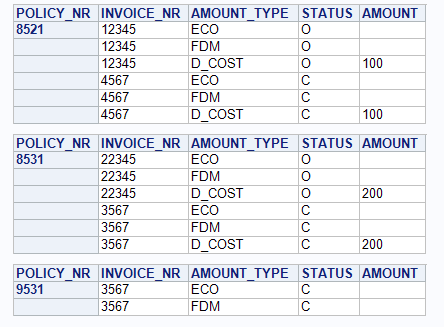- Home
- /
- Programming
- /
- SAS Procedures
- /
- Re: Combining two data sets in a specific way
- RSS Feed
- Mark Topic as New
- Mark Topic as Read
- Float this Topic for Current User
- Bookmark
- Subscribe
- Mute
- Printer Friendly Page
- Mark as New
- Bookmark
- Subscribe
- Mute
- RSS Feed
- Permalink
- Report Inappropriate Content
I need to combine two data sets in a specific way, and could use some advice.
Input #1:
| POLICY_NR | INVOICE_NR | AMOUNT_TYPE | STATUS |
|---|---|---|---|
| 8521 | 12345 | ECO | O |
| 8521 | 12345 | FDM | O |
| 8521 | 4567 | ECO | C |
| 8521 | 4567 | FDM | C |
Input #2:
| POLICY_NR | AMOUNT_TYPE | AMOUNT |
|---|---|---|
| 8521 | D_COST | 100 |
Desired output:
| POLICY_NR | INVOICE_NR | AMOUNT_TYPE | AMOUNT | STATUS |
|---|---|---|---|---|
| 8521 | 12345 | ECO | O | |
| 8521 | 12345 | FDM | O | |
| 8521 | 12345 | D_COST | 100 | O |
| 8521 | 4567 | ECO | C | |
| 8521 | 4567 | FDM | C | |
| 8521 | 4567 | D_COST | 100 | C |
Everything has the same POLICY_NR. Input #2 needs to be appended into Input #1 two times: once for each INVOICE_NR. When it's appended, the respective INVOICE_NR and STATUS need to be filled out for each of the two rows with AMOUNT_TYPE=D_COST.
Thanks for any suggestions you might give me in regards to this.
Accepted Solutions
- Mark as New
- Bookmark
- Subscribe
- Mute
- RSS Feed
- Permalink
- Report Inappropriate Content
I think using a KEYed SET would work nicely.
input (POLICY_NR INVOICE_NR AMOUNT_TYPE STATUS)($);
cards;
8521 12345 ECO O
8521 12345 FDM O
8521 4567 ECO C
8521 4567 FDM C
8531 22345 ECO O
8531 22345 FDM O
8531 3567 ECO C
8531 3567 FDM C
9531 3567 ECO C
9531 3567 FDM C
;;;;
run;
data two(index=(policy_nr));
input (POLICY_NR AMOUNT_TYPE AMOUNT)($);
cards;
8521 D_COST 100
8531 D_COST 200
;;;;
run;
data three;
set one;
by policy_nr invoice_nr;
output;
if last.invoice_nr then do;
set two key=policy_nr/unique;
if _iorc_ eq 0 then output;
else _error_=0;
end;
call missing(amount);
run;
proc print;
by policy_nr;
id policy_nr;
run;

- Mark as New
- Bookmark
- Subscribe
- Mute
- RSS Feed
- Permalink
- Report Inappropriate Content
Hello,
One solution:
data master;
input POLICY_NR INVOICE_NR AMOUNT_TYPE $ STATUS $;
datalines;
8521 12345 ECO O
8521 12345 FDM O
8521 4567 ECO C
8521 4567 FDM C
8522 4567 FDM C
8523 4567 FDM C
;
data updatee;
input POLICY_NR AMOUNT_TYPE $ AMOUNT ;
datalines;
8521 D_COST 100
8522 D_COST 100
;
proc sort data=master;
by POLICY_NR INVOICE_NR;
run;
data want;
set master;
length amount 8;
if _n_=1 then do;
call missing(amount);
declare hash u(dataset:"updatee");
u.definekey('POLICY_NR');
u.definedata('AMOUNT_TYPE','AMOUNT');
u.definedone();
end;
by POLICY_NR INVOICE_NR;
if last.INVOICE_NR then do;
output;
if u.find() eq 0 then output;
end;
else output;
run;
- Mark as New
- Bookmark
- Subscribe
- Mute
- RSS Feed
- Permalink
- Report Inappropriate Content
As an alternative, use conditional output statements on a merged dataset (using Loko's test data):
data want;
merge master updatee (rename=(amount_type=amountt amount=amt));
by policy_nr;
run;
proc sort data=want;
by policy_nr invoice_nr;
run;
data want2 (drop=amountt amt);
set want;
by policy_nr invoice_nr;
length amount $10;
if last.invoice_nr then do;
output;
amount_type=amountt;
amount=amt;
output;
end;
else output;
run;
- Mark as New
- Bookmark
- Subscribe
- Mute
- RSS Feed
- Permalink
- Report Inappropriate Content
I think using a KEYed SET would work nicely.
input (POLICY_NR INVOICE_NR AMOUNT_TYPE STATUS)($);
cards;
8521 12345 ECO O
8521 12345 FDM O
8521 4567 ECO C
8521 4567 FDM C
8531 22345 ECO O
8531 22345 FDM O
8531 3567 ECO C
8531 3567 FDM C
9531 3567 ECO C
9531 3567 FDM C
;;;;
run;
data two(index=(policy_nr));
input (POLICY_NR AMOUNT_TYPE AMOUNT)($);
cards;
8521 D_COST 100
8531 D_COST 200
;;;;
run;
data three;
set one;
by policy_nr invoice_nr;
output;
if last.invoice_nr then do;
set two key=policy_nr/unique;
if _iorc_ eq 0 then output;
else _error_=0;
end;
call missing(amount);
run;
proc print;
by policy_nr;
id policy_nr;
run;

April 27 – 30 | Gaylord Texan | Grapevine, Texas
Registration is open
Walk in ready to learn. Walk out ready to deliver. This is the data and AI conference you can't afford to miss.
Register now and save with the early bird rate—just $795!
Learn the difference between classical and Bayesian statistical approaches and see a few PROC examples to perform Bayesian analysis in this video.
Find more tutorials on the SAS Users YouTube channel.
SAS Training: Just a Click Away
Ready to level-up your skills? Choose your own adventure.


